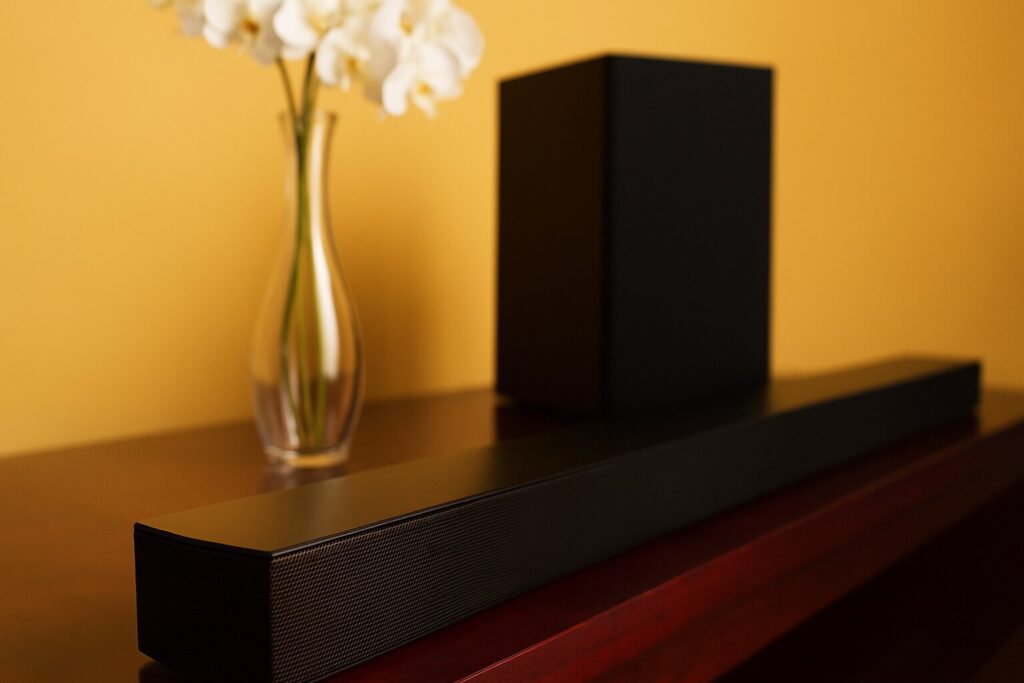Table of Contents
- Quick Overview
- Samsung HW-B550F Soundbar Specifications
- What’s in the Box?
- Dialogue Boost: Samsung Voice Enhance and Night Mode
- Plug and Play: HDMI ARC and Auto-Pairing
- Build and Design
- Reliability
- Value Assessment
- Should You Buy the Samsung HW-B550F Soundbar?
Quick Overview
Who it’s for: The Samsung HW-B550F 2.1 ch Soundbar makes sense if you’re tired of thin TV audio and want dialogue you can actually hear, plus bass that adds weight to what you’re watching, all without spending several hundred more. It works best with Samsung TVs but handles other brands too.
The deal: You get noticeably better sound than your TV can produce – movies feel more immersive, music has depth, and you can actually hear what people are saying. Setup takes about 10 minutes.
The catch: Some users find their subwoofer occasionally stops pairing – usually fixable by following the reset steps in the manual. Mounting it properly might require extra hardware, but at this price point, most alternatives have similar trade-offs.
Bottom line: If you need better TV audio on a budget and you’re okay with “very good for the money” rather than “best in class,” this delivers.

Samsung HW-B550F Soundbar Specifications
- Sound Bar Size (INCHES WxHxD): 33.81″ x 2.32″ x 2.95″
- Subwoofer Size (INCHES WxHxD): 7.24″ x 13.5″ x 11.64″
- Speaker Maximum Output Power: 300 watts
- Connections: Optical, HDMI (ARC), USB
What’s in the Box?
- Soundbar and (4.9 ft / 1.5m) power cord
- Subwoofer and (4.9 ft / 1.5m) power cord
- Optical cable (4.9 ft / 1.5m)
- Wall mount kit
- Remote controller with batteries (2x AA)
Note: The HDMI cord is not supplied.
Dialogue Boost: Samsung Voice Enhance and Night Mode
The audio is a clear step up from TV speakers. Dialogue comes through cleanly even at moderate volumes, which matters if you watch late at night or have the windows open. The mid-range handles voices and instruments well – you’ll hear details in music tracks that cheaper speakers gloss over. The subwoofer adds noticeable low-end for movie explosions and music bass lines, though it won’t deliver the deepest frequencies in action scenes or music with prominent bass like hip-hop. Highs and mids stay distinct rather than blending into mush.
The system gets loud when you want it to. People mention being surprised by how much volume it can push without distorting. You can switch between sound modes depending on what you’re watching (movies, sports, music).
Samsung Soundbar Voice Enhance: On or Off?
Turn Voice Enhance on if dialogue feels buried under background noise or effects – it’s ideal for complex movie mixes, hearing-impaired viewers, or late-night viewing without waking others. It boosts speech clarity by increasing center-channel volume, making voices stand out. Turn it off for music, action scenes, or immersive soundtracks where you want balanced audio without muffled effects or unbalanced highs/lows.
Quick toggle via remote: Press the Sound Control button (gear icon) repeatedly until “Voice Enhance” shows on the display. Use up/down arrows to switch on/off. For extra clarity, press CH LEVEL until “Center” appears, then adjust (+/-6 dB).
Via SmartThings app: Open app > Devices > select soundbar > Advanced Sound Settings > toggle Voice Enhance. Boost further under Channel Level > Center slider (up to +6 dB).
A Night Mode keeps volume balanced between quiet dialogue and loud explosions – perfect for apartments or bedtime viewing. Pair with Voice Enhance for crystal-clear speech at low levels.
The surround processing can genuinely catch you off guard – sounds seem to come from behind or beside you convincingly enough that you might glance around the room. It’s not true positional audio like dedicated rear speakers provide, but the effect works better than you’d expect from a soundbar-and-sub setup, particularly with film soundtracks that have layered ambient noise.
The main limitation is format support: this is a 2.1 setup, so it handles stereo content and standard surround formats, but it can’t process Dolby Atmos or give you discrete multi-channel separation. If you’re streaming content with those advanced formats, you’re not getting the full spatial experience. For everyday TV shows, YouTube, music streaming, gaming and most movies, it does what you need.
Plug and Play: HDMI ARC and Auto-Pairing
Most people have this running within 10-15 minutes. HDMI ARC is the cleanest connection method – plug the HDMI cable into your TV’s HDMI IN (ARC) or (eARC) port and the soundbar’s HDMI (ARC) port, and you’ll control volume through your TV remote. You’ll need to supply your own HDMI cable as one isn’t included in the box. The wireless subwoofer pairs itself automatically in most cases. If you’ve got a Samsung TV, it’s genuinely plug-and-play.
Optical and Bluetooth Connection
The complications may show up with non-Samsung TVs and older HDMI cables. Some users find the manual’s instructions don’t quite match their actual model, so they end up googling for setup guides. Optical cable works as a backup, but you lose some convenience features. Bluetooth pairing for music from your phone is straightforward and stays connected reliably.
Remote Control and Missing Smart Features
The remote itself is basic and not particularly intuitive – you’ll spend some time figuring out which buttons do what.
There’s no app control or Wi-Fi connectivity if that matters to you. This means you can’t use the Samsung SmartThings app to adjust settings from your phone, and streaming Spotify requires a workaround: you’ll need to turn on your TV, open the Spotify app from the TV’s menu, then play through the soundbar. You can use Bluetooth to play music directly from your phone, but you lose the convenience of browsing your library on the TV screen.
Build and Design
The soundbar is compact and looks fine sitting under a TV – nothing flashy, just a simple black bar that doesn’t call attention to itself. It won’t dominate your entertainment center.
Wall mounting is where things get tricky for some. The included brackets work, but you will need to buy additional screws or adapters depending on your wall type and stud spacing. Samsung doesn’t provide these, which feels like an odd omission for a product that many people will want to mount. Budget an extra trip to the hardware store and maybe 30 minutes more installation time.
The subwoofer connects to the soundbar wirelessly, so you can place it wherever works in your room without running an audio cable between them. You’ll still need to plug it into a power outlet.
Reliability
Some users report subwoofer problems – strange noises, disconnection issues, or failure to pair – but most people don’t experience these issues. The system typically works fine and stays reliable, though it’s worth being aware these problems occasionally show up in Amazon reviews.
Samsung Subwoofer Not Connecting? Here’s the Fix
To pair your Samsung soundbar with the subwoofer, try this process:
Method 1 (official Samsung troubleshooting steps):
- Press and hold the ID Set button on the back of the subwoofer until the blue light starts blinking.
- Keep the soundbar turned off. Press and hold the Mute button on your remote until “ID SET” appears on the soundbar display.
- While the subwoofer’s blue light is still blinking, turn on the soundbar.
- The blue light should stop blinking and stay solid – you’re now connected.
Method 2 (alternative method if Method 1 doesn’t work):
- Find the ID Set button on the back of the subwoofer. Press and hold it – the red light turns on first, then after 5 seconds it switches off and the blue light starts blinking.
- Turn on your soundbar and press any button to wake the display.
- Press and hold the Up button on the soundbar’s directional pad for 5 seconds until “ID SET” appears on the display.
- The subwoofer’s blue light should stop blinking and stay solid – you’re paired.
Value Assessment
At its typical price (around $210), you’re getting hardware that performs like you’d expect for that money and it does what budget soundbars should do: make TV audio noticeably better without complicated setup or huge expense.
Compared to similarly priced options from other brands, the B550F holds its own in sound quality and features. You can add rear speakers later if you want to expand the surround setup (e.g. Samsung 9250S Wireless Rear Speaker Kit) which gives you an upgrade path without replacing the whole system.
Should You Buy the Samsung HW-B550F Soundbar?
Buy this if your TV speakers sound hollow and dialogue gets lost in the mix, you want bass that actually registers without spending much more money, and you’re comfortable with Amazon’s return window to test for potential issues. It’s particularly straightforward if you own a Samsung TV.
Skip it if you want Dolby Atmos or true 5.1 surround sound. This system downmixes multi-channel formats like Dolby Digital into stereo, so you won’t get that true immersive, room-filling effect. Also skip it if you want to control the soundbar through a phone app rather than the physical remote, or if Wi-Fi connectivity matters for your setup.
The practical move: Amazon’s 30-day return policy gives you enough time to properly test the unit. Run it at different volumes, check the subwoofer stays connected, and try various content types. If everything’s working well by the end of that window, you’ve likely got a good unit and you’re set for decent TV audio at a fair price.
Want another budget soundbar worth checking out? Read our TCL S45H soundbar review.

